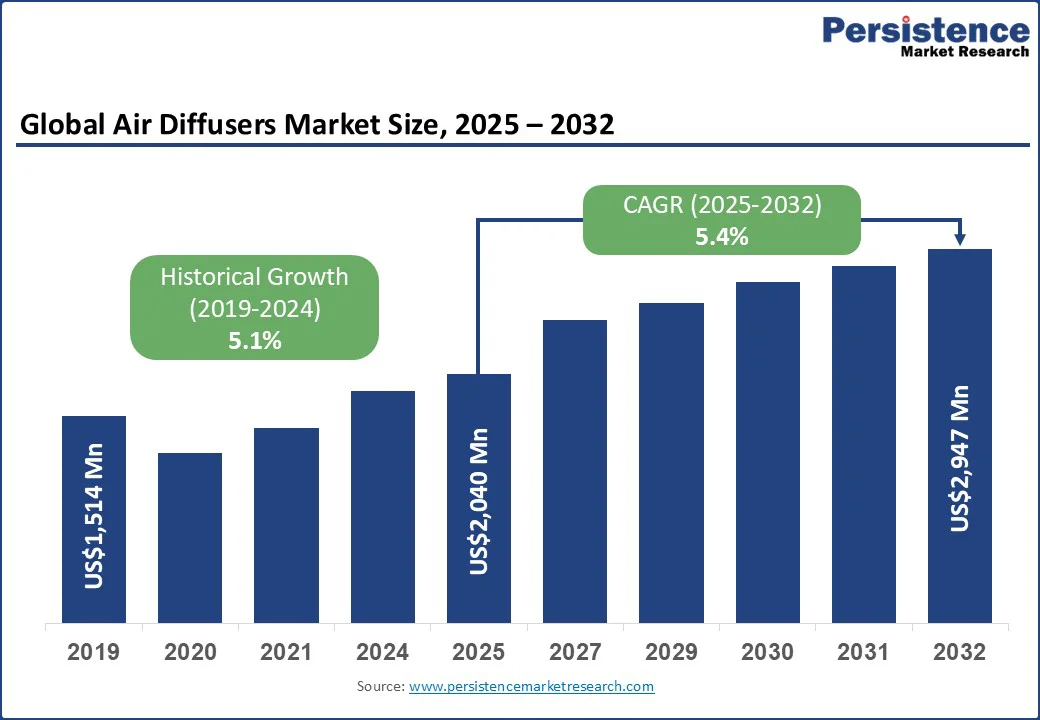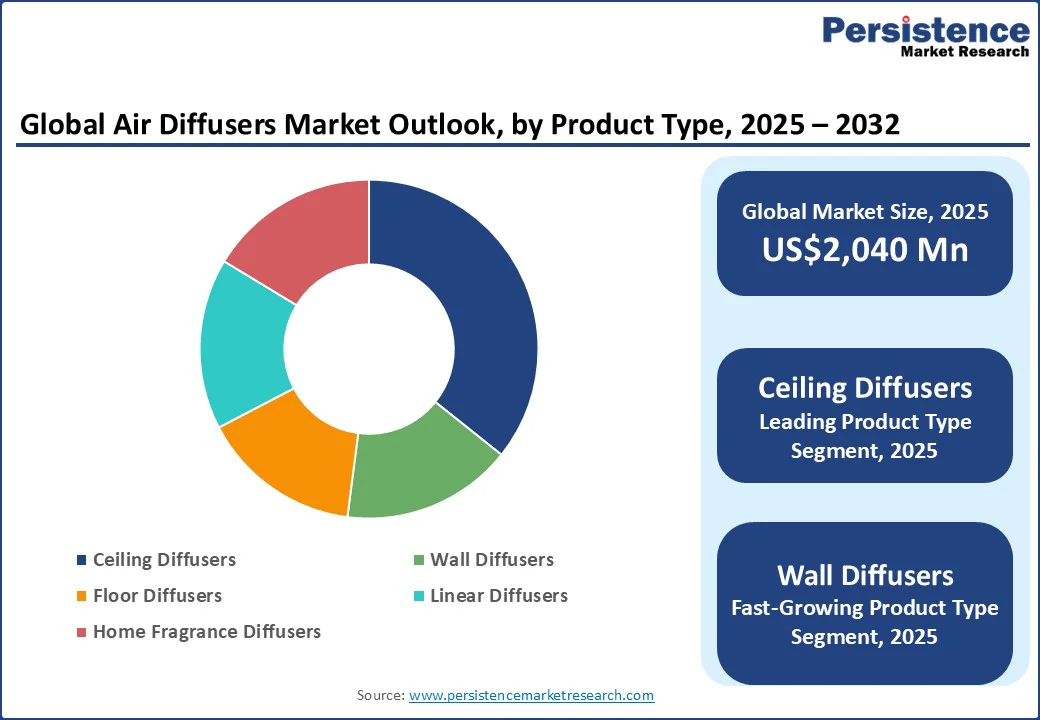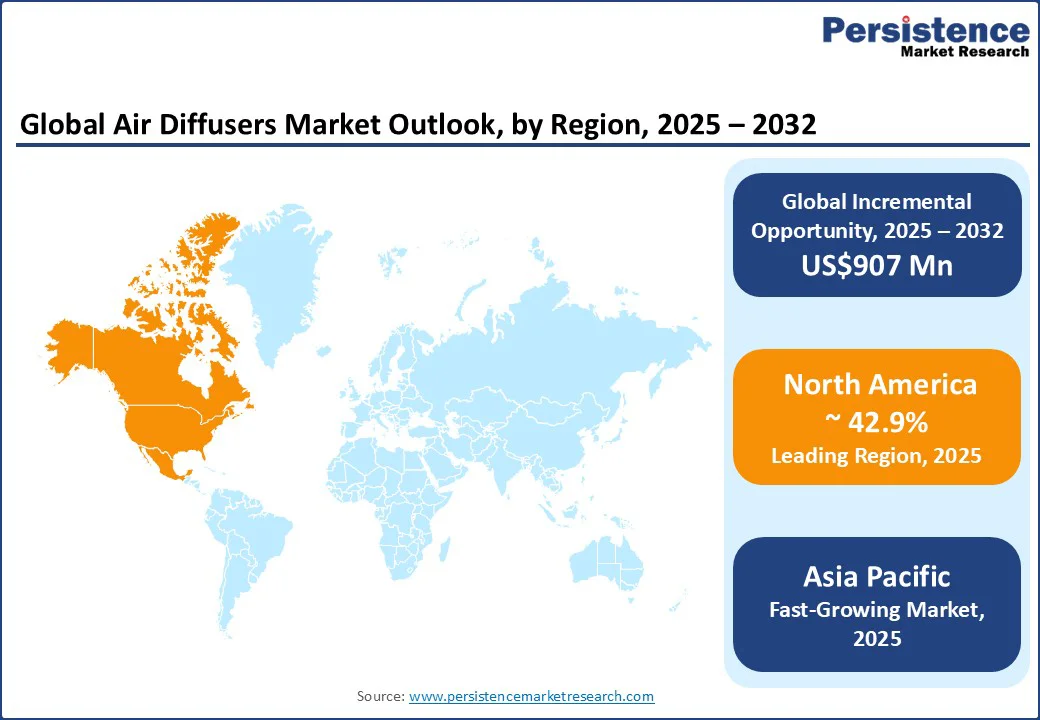ID: PMRREP35638| 187 Pages | 22 Sep 2025 | Format: PDF, Excel, PPT* | Consumer Goods

The global air diffusers market size is likely to be valued at US$2,040 Mn in 2025 and is expected to reach US$2,947 Mn by 2032, growing at a CAGR of 5.4% during the forecast period from 2025 to 2032, driven by the rising demand for efficient ventilation and indoor air quality solutions across residential, commercial, and industrial sectors.
Key Industry Highlights:

| Key Insights | Details |
|---|---|
| Air Diffusers Market Size (2025E) | US$2,040 Mn |
| Market Value Forecast (2032F) | US$2,947 Mn |
| Projected Growth (CAGR 2025 to 2032) | 5.4% |
| Historical Market Growth (CAGR 2019 to 2024) | 5.1% |
The integration of smart HVAC systems is reshaping the air diffusers market by enhancing energy efficiency and indoor air quality. These systems utilize IoT connectivity, sensors, and app-based controls to optimize airflow and monitor environmental conditions in real-time. For example, smart diffusers can adjust ventilation based on occupancy and air quality data, reducing energy consumption and improving comfort.
This trend is particularly prominent in commercial buildings and regions with stringent energy efficiency regulations, such as North America and Europe. The demand for smart HVAC diffusers is further fueled by the growing emphasis on sustainable building practices and the need for adaptable indoor environments.
Rapid urbanization is driving the demand for efficient air distribution solutions in densely populated areas. As cities expand, the construction of high-rise buildings and large commercial complexes necessitates advanced HVAC systems to ensure optimal indoor air quality and comfort. The increasing focus on wellness and environmental sustainability in urban planning further accelerates the adoption of innovative air diffuser technologies.
For instance, in regions such as Asia Pacific, the rise in disposable incomes and urban development is contributing to the growing popularity of aromatherapy and wellness-oriented air diffusion systems. This urban shift underscores the need for scalable and effective air distribution solutions to meet the evolving demands of modern infrastructure.
Competition from alternative products continues to influence the air diffusers market, particularly from items including air fresheners and scented candles. These substitutes offer lower upfront costs and are widely available in retail outlets, making them appealing for consumers seeking quick and convenient solutions for indoor air quality or ambiance.
In price-sensitive markets, the preference for these accessible and budget-friendly alternatives can reduce the adoption of advanced air diffusers. For example, in regions with high demand for low-cost options, scented candles often replace diffusers as the preferred choice for creating a pleasant indoor environment.
The limited availability of natural oils also affects the growth of the fragrance diffuser segment. Environmental concerns around resource depletion and sustainable harvesting practices have tightened the supply of certain essential oils, which are key ingredients in many diffusers.
This restricted supply can lead to higher production costs and occasional shortages, impacting both pricing and product availability. Manufacturers relying on high-quality natural oils must navigate these supply challenges while maintaining consistent product offerings to meet consumer expectations.
The air diffusers market is poised for significant growth, driven by several emerging opportunities that cater to evolving consumer preferences and technological advancements. One notable opportunity lies in the integration of air diffusers with smart HVAC systems. These systems utilize IoT connectivity and sensors to optimize airflow, enhancing energy efficiency and indoor air quality.
For instance, smart diffusers can adjust ventilation based on real-time occupancy and air quality data, reducing energy consumption and improving comfort. This trend is particularly evident in regions, including North America and Europe, where stringent energy efficiency regulations and a growing emphasis on smart building technologies are driving demand for intelligent air distribution solutions.
Another promising avenue for market expansion is the increasing focus on wellness and indoor air quality. Consumers are becoming more conscious of the air they breathe, leading to a surge in demand for products that promote healthier living environments.
Air diffusers, especially those designed for aromatherapy, play a crucial role in this wellness trend by dispersing essential oils that can improve mood, reduce stress, and enhance overall well-being. The growing popularity of home wellness products presents a unique opportunity for air diffuser manufacturers to innovate and cater to this health-conscious consumer base.
Among product types, ceiling diffusers are expected to hold the largest market share of approximately 34.6% in 2025. Their dominance is primarily due to their widespread use in commercial and industrial HVAC systems, where uniform air distribution and energy efficiency are critical.
Ceiling diffusers are highly effective in large spaces such as office buildings, airports, and factories, providing consistent airflow while maintaining thermal comfort. Their robust design, adaptability to different HVAC layouts, and ability to integrate with smart HVAC systems make them the preferred choice for large-scale installations.
For example, major commercial complexes in North America often rely on ceiling diffusers combined with sensor-driven ventilation to optimize energy use and air circulation.
Wall diffusers, on the other hand, are the fastest-growing segment within the product type category. This growth is driven by the increasing demand for space-saving, aesthetically appealing solutions in modern architecture and high-end residential and commercial projects.
Unlike ceiling diffusers, wall-mounted systems are ideal for retrofitting existing spaces and for areas where ceiling installation is not feasible. Their ability to deliver targeted airflow while complementing interior design trends has boosted adoption.
In luxury hotels and upscale residential buildings, wall diffusers are being installed not just for functional airflow but also as part of the overall design aesthetic, reflecting the rising preference for integrated and visually discreet HVAC solutions.
Within the end-user category, residential applications represent the largest segment of the air diffusers market, with a projected share of nearly 39.8% in 2025. This leadership is driven by growing awareness among homeowners about indoor air quality and the increasing adoption of smart home technologies.
Homeowners are investing in diffusers that enhance comfort, regulate airflow efficiently, and even integrate with IoT-enabled smart HVAC systems for automated control. The trend toward wellness-focused living spaces, where air quality, aromatherapy, and environmental comfort are prioritized, has further reinforced this segment’s prominence.
For instance, many modern apartments in North America now feature smart ceiling and wall diffusers that adjust airflow based on occupancy patterns, improving both energy efficiency and indoor comfort.
Commercial applications are the fastest-growing end-user segment. This is due to the rising demand for energy-efficient HVAC systems and improved indoor air quality in offices, retail spaces, and public buildings. Businesses are increasingly prioritizing employee comfort and productivity, which has accelerated the installation of advanced diffusers capable of precise airflow management and integration with building management systems.
In large shopping malls and corporate offices, smart ceiling and wall diffusers are being deployed to optimize air distribution, reduce energy costs, and maintain a healthy indoor environment, making commercial spaces a high-growth target for diffuser manufacturers.

North America is expected to hold a dominant position in the air diffusers market, accounting for approximately 42.9% of the total market share in 2025. This leadership is primarily driven by the region’s advanced infrastructure, heightened consumer awareness, and a growing emphasis on wellness and indoor air quality.
In the U.S., there is a strong and consistent demand for both ceiling and wall diffusers, largely due to the increasing adoption of smart HVAC systems and energy-efficient solutions in both residential and commercial sectors.
Companies such as Titus HVAC and Price Industries are leading the way by offering advanced air distribution systems with features such as automatic airflow balancing and integration with building automation systems (BAS). For example, the Titus EOS diffuser line includes demand-controlled ventilation, which enhances energy savings and indoor comfort.
In Canada, growing urban development and sustainability-focused building codes are shaping consumer behavior. Green building certifications such as LEED are encouraging developers to install low-noise, high-efficiency diffusers in commercial spaces.
Canadian firms are also importing or producing eco-friendly air diffusers that align with ASHRAE 62.1 indoor air quality standards. One notable project is the Toronto Waterfront Redevelopment, where modern HVAC and air diffusion systems are integrated into mixed-use buildings with an emphasis on indoor environmental quality.
The Asia Pacific region represents the fastest-growing market for air diffusers globally. This growth is fueled by rapid urbanization, rising disposable incomes, and increasing awareness of indoor air quality. In China, cities such as Shanghai, Beijing, and Shenzhen are witnessing a surge in smart home and office buildings that use intelligent air diffusion systems.
Domestic companies such as Midea Group and Gree Electric Appliances are incorporating IoT-enabled air diffusers into their smart HVAC product lines. These systems can auto-adjust airflow and filter quality based on occupancy and air quality sensors. A notable development includes the Beijing Daxing International Airport, where advanced linear slot diffusers were deployed to efficiently manage air flow in large public spaces.
In India, metropolitan regions such as Delhi NCR, Bangalore, and Mumbai are leading the demand for diffusers in both commercial and residential construction. The launch of large-scale commercial buildings, including Embassy TechVillage, in Bangalore, is seeing increased use of customized linear and slot diffusers to optimize energy use while maintaining comfort.
Indian HVAC manufacturers and distributors are increasingly offering modular diffuser systems that cater to space constraints and energy efficiency goals.
Europe holds a substantial share of the air diffusers market, supported by strict environmental regulations and a strong focus on energy-efficient building practices. The region benefits from mature infrastructure and high standards for indoor air quality, making air diffusers a standard feature in modern commercial and residential architecture.
In Germany, the demand is particularly strong for ceiling and linear diffusers in industrial and commercial applications. German HVAC firms such as Trox GmbH offer advanced systems, such as the Varydiff ceiling swirl diffusers, designed for large-volume spaces while maintaining optimal acoustic and thermal comfort.
Major construction projects such as the Berlin Brandenburg Airport have utilized high-performance air diffusion systems to meet stringent environmental and comfort standards.
In France, aesthetic design plays a key role. The market shows a growing preference for wall and floor diffusers, especially in the residential sector. French interior designers and architects increasingly incorporate designer air diffusers from brands such as Aldes and Unelvent, which blend well with modern interiors.
For instance, Aldes developed invisible air diffusers that integrate seamlessly into walls, providing both functionality and minimalistic aesthetics. Residential renovation programs under the MaPrimeRénov’ scheme have also boosted the adoption of energy-efficient ventilation and diffuser systems across French households.

The global air diffusers market is highly competitive, featuring a mix of established HVAC solution providers and specialized diffuser manufacturers.
Key players such as Trox GmbH, Krueger-HVAC, Price Industries, Systemair AB, Greenheck Fan Corporation, and Daikin Industries dominate the landscape, leveraging technological innovation, energy-efficient designs, and smart HVAC integrations to maintain market leadership.
Companies are increasingly focusing on product differentiation through low-noise, aesthetically appealing, and IoT-enabled diffuser solutions to cater to residential, commercial, and industrial segments.
Strategic partnerships, acquisitions, and regional expansions are common approaches to enhance distribution networks and strengthen market presence. Additionally, rising consumer demand for wellness-focused and aromatherapy-compatible diffusers has prompted manufacturers to introduce specialized offerings, positioning themselves competitively in both mature and emerging markets.
| Report Attribute | Details |
|---|---|
| Historical Data/Actuals | 2019 - 2024 |
| Forecast Period | 2025 - 2032 |
| Market Analysis | Value: US$ Mn |
| Geographical Coverage |
|
| Segmental Coverage |
|
| Competitive Analysis |
|
| Report Highlights |
|
By Product Type
By Material
By Application
By End-user
By Region
Delivery Timelines
For more information on this report and its delivery timelines please get in touch with our sales team.
About Author